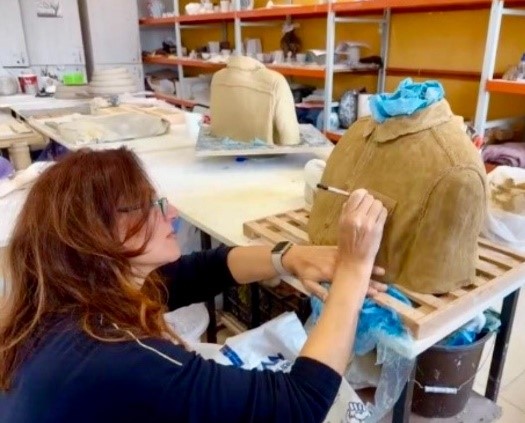MELTEM ÇÖMLEKÇİOĞLU (Kocaeli, 1970)
Kocaeli Üniversitesi, Seramik Bölümü
Bedensiz Kimlikler / Disembodied Identities, 2025
Seramik, şamotlu çamur, 31x49x31cm, 30x43x25 cm
Ceramics, chamotte clay, 31x49x31 cm, 30x43x25 cm
“Bedensiz Kimlikler” adlı çalışma George Orwell’in 1984 distopyasından hareketle, totaliter gözetim rejimlerinin bireyin benliğini sistematik biçimde silme süreçlerini ele almaktadır. Kadın ve erkek torsoları, gözetim baskısıyla dönüşmüş cinsiyet göstergesi dışında tüm insani niteliklerden arındırılmış; yüzsüz, jestsiz ve tek tip formlara dönüştürülmüştür. Formdaki bireyin yerine geçen kimlik numarası, insanın veri düzeyine indirgenişini temsil eder. Sırlanmamış yüzeyler, bastırılmışlığı ve ruhsuzluğu; pürüzlü dokular ise kimliğin silinme sürecinde açılan yarıkları imler. Yan yana konumlanan formlar, toplumsal cinsiyetin ötesine geçen tekil bir düzenin birey üzerindeki mutlak hâkimiyetini görünür kılar. Bedenleri yok olmuş sistemin içinde var olan ama artık yaşamayan bedensiz kimlikler sistemin kodladığı sessiz gölgelerdir. Yerdeki, sistemin varettiği bedensiz kimlik numaraları ise sistemin etki alanının büyüklüğünün ifadesidir ve gözetimin hafızasız bedenleridir.
Sorunun yankısı mekanda asılı kalır;
Kimliğimiz bize mi ait yoksa sistemin giydirdiği bir üniforma mı?
Drawing on George Orwell’s dystopia, 1984, the work explores the systematic erasure of the individual’s self by totalitarian surveillance regimes. Male and female torsos, stripped of all human qualities except for the gender indicator transformed by the pressure of surveillance, are transformed into faceless, gestureless, and uniform forms. The identity number, which replaces the individual within the form, represents the reduction of humanity to the level of data. Unglazed surfaces suggest repression and soullessness, while rough textures suggest the gaps opened in the process of erasing identity. The juxtaposed forms make visible the absolute dominance of a singular order that transcends gender over the individual. The disembodied identities, whose bodies exist within the system that has vanished but are no longer alive, are silent shadows encoded by the system. The disembodied identity numbers created by the system on the ground express the vastness of the system’s reach and are the memoryless bodies of surveillance.
The echo of the question lingers in the space:
Does our identity belong to us, or is it a uniform imposed by the system?
Sanatçı ve eserle ilgili daha fazla bilgi almak için info@base.ist adresine e-posta atmanızı rica ederiz.
“Bedensiz Kimlikler” adlı çalışma George Orwell’in 1984 distopyasından hareketle, totaliter gözetim rejimlerinin bireyin benliğini sistematik biçimde silme süreçlerini ele almaktadır. Kadın ve erkek torsoları, gözetim baskısıyla dönüşmüş cinsiyet göstergesi dışında tüm insani niteliklerden arındırılmış; yüzsüz, jestsiz ve tek tip formlara dönüştürülmüştür. Formdaki bireyin yerine geçen kimlik numarası, insanın veri düzeyine indirgenişini temsil eder. Sırlanmamış yüzeyler, bastırılmışlığı ve ruhsuzluğu; pürüzlü dokular ise kimliğin silinme sürecinde açılan yarıkları imler. Yan yana konumlanan formlar, toplumsal cinsiyetin ötesine geçen tekil bir düzenin birey üzerindeki mutlak hâkimiyetini görünür kılar. Bedenleri yok olmuş sistemin içinde var olan ama artık yaşamayan bedensiz kimlikler sistemin kodladığı sessiz gölgelerdir. Yerdeki, sistemin varettiği bedensiz kimlik numaraları ise sistemin etki alanının büyüklüğünün ifadesidir ve gözetimin hafızasız bedenleridir.
Sorunun yankısı mekanda asılı kalır;
Kimliğimiz bize mi ait yoksa sistemin giydirdiği bir üniforma mı?
Drawing on George Orwell’s dystopia, 1984, the work explores the systematic erasure of the individual’s self by totalitarian surveillance regimes. Male and female torsos, stripped of all human qualities except for the gender indicator transformed by the pressure of surveillance, are transformed into faceless, gestureless, and uniform forms. The identity number, which replaces the individual within the form, represents the reduction of humanity to the level of data. Unglazed surfaces suggest repression and soullessness, while rough textures suggest the gaps opened in the process of erasing identity. The juxtaposed forms make visible the absolute dominance of a singular order that transcends gender over the individual. The disembodied identities, whose bodies exist within the system that has vanished but are no longer alive, are silent shadows encoded by the system. The disembodied identity numbers created by the system on the ground express the vastness of the system’s reach and are the memoryless bodies of surveillance.
The echo of the question lingers in the space:
Does our identity belong to us, or is it a uniform imposed by the system?
Sanatçı ve eserle ilgili daha fazla bilgi almak için info@base.ist adresine e-posta atmanızı rica ederiz.

